By Claire Bacon, ACN, CNC
If you’re new to the natural health world, you may be feeling an odd sense of questioning everything around you. Just what exactly is a “toxin?” The things you accepted previously as “normal” might be standing out a little more as, “is this something I need in my life” and “is this not really healthy for me?” I remember very clearly my reaction to a four-day Lifestyle Implementation Camp with a bunch of chiropractors and health nuts: I spent a five-hour plane ride journaling non-stop about how I felt betrayed by every piece of marketing and advertising and every doctor I had ever asked for health advice. I wonder if people are starting to feel that way about America’s favorite weed killer, RoundUp, and its active ingredient, Glyphosate? Because it turns out, glyphosate is in just about everything we consume.
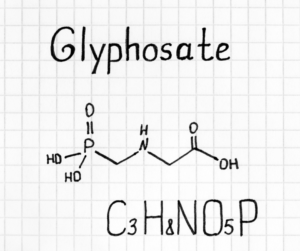
A Little Back Story…
It was just a few years ago, a friend mentioned I could speed up my yard work and weeding if I would just spray down the weeds on my walkway with RoundUp, rather than pulling them out by hand. I responded that no, there was too much risk for causing cancer and reproductive harm, so I didn’t mind taking the extra time. His reaction was one of disbelief: “Oh no – every bit of that chemical degrades and fades away within a week. I don’t know what kind of propaganda he had been reading, but that wasn’t true. And then came the landmark August 2018 court case, where a California jury determined that Dewayne Johnson’s non-Hodgkins Lymphoma was caused by glyphosate – the active ingredient of the RoundUp he used regularly as a school groundskeeper.
“Mr Johnson’s attorneys sought and won $US39 million in compensatory damages and $US250 million in punitive damages. ‘This jury found Monsanto acted with malice and oppression because they knew what they were doing was wrong and doing it with reckless disregard for human life,’ said Robert F Kennedy Jr, a member of Mr. Johnson’s legal team.”
Later, Monsanto appealed, and the damages were reduced to $78 million.
Even before that case, the France-based International Agency for Research on Cancer, which is part of the World Health Organization, classified glyphosate as a “probable human carcinogen” in 2015. And back in 2017, California added glyphosate to its list of “Proposition 65” chemicals known to cause cancer.
At this time, there are estimated to be thousands of cases pending in the courts. Monsanto has settled over 100,000 Roundup lawsuits, paying out about $11 billion as of May 2022. For the past few years, Bayer and other large agricultural companies have been slowly phasing out their production of RoundUp, and transitioning to other weed killer products. However, scientists say the new Liberty option is no safer.
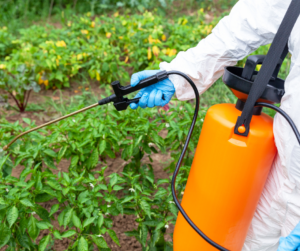
History of Glyphosate’s Approvals and Expansion of Use
Early Years
- 1961: Glyphosate receives patent as a Descaling and Chelating Agent by the Stauffer Chemical Company.
- 1970: Glyphosate was discovered to be a herbicide (weedkiller) by Monsanto scientist John Franz and was patented as such.
- 1974: Monsanto brought glyphosate to market under the trade name Roundup.
- Early 1980s: Monsanto was already working on creating Roundup Ready genetically modified crops.
- 1985: The US Environmental Protection Agency (EPA) classified glyphosate as a Class C Carcinogen, and Monsanto presented counterarguments.
- 1989: Monsanto strikes deal with Asgrow and Agracetus to create Roundup Ready genetically modified crops for commercial market, most notably, soybeans.
Now the Trouble Starts
- 1991: EPA changes classification of glyphosate from Class C “Suggestive evidence of carcinogenic potential” to Class E which suggests “evidence of non-carcinogenicity for humans”. Mysteriously, this change occurred during the same period that Monsanto was developing its first Roundup-Ready (glyphosate-resistant) GM Crops.
- 1996: Roundup Ready soybeans were commercialized by Asgrow in coordination with Monsanto and separately by Pioneer (DuPont). In 1996, glyphosate accounted for just 3.8% of the total volume of herbicide active ingredients applied in agriculture (28 million pounds in 1995). Also in 1996, wheat crops began being sprayed with Round Up at time of harvest, as a way to speed production and reduce maintenance costs on the equipment.
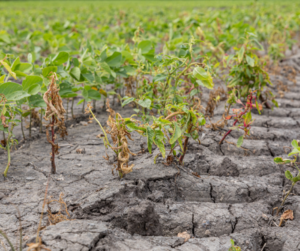
Spreading Rampantly
- 2007: Glyphosate usage is more than double that of the next most heavily sprayed pesticide – Atrazine (the one that turns male frogs into females).
- 2010: Glyphosate receives patent approval as an antibiotic. This patent shows the harm due to glyphosate including the killing of beneficial gut bacteria which causes immune system damage.
- 2012: Professor Seralini’s study shows severe liver and kidney harm in rats from low doses of glyphosate-based herbicides and GM crops. It was the most high-profile and long-term study to date.
- 2015: The World Health Organization’s cancer agency IARC classified glyphosate as “probably carcinogenic to humans” (Group 2A) with “strong” evidence for genotoxicity, both for “pure” glyphosate and for glyphosate formulations.
Scientists and Food Babe Start Making Waves
- 2016: University of California San Francisco (UCSF) study discovers glyphosate in 93% of urine samples collected across U.S. Collaborators included The Detox Project and the Organic Consumers Association.
- 2016: Alarming levels of glyphosate contamination found in popular American foods: General Mills’ Cheerios and Honey Nut Cheerios, Kellogg’s Corn Flakes, Raisin Bran and Frosted Flakes and PepsiCo’s Doritos Cool Ranch, Ritz Crackers and Stacy’s Simply Naked Pita Chips, as well as many more famous products. Click the link!
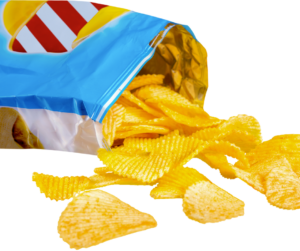
- 2017: A peer-reviewed study led by Dr Michael Antoniou at King’s College London evaluated the livers of female rats administered with a real-world, low dose of Roundup weedkiller over a 2-year period. The small dose of Roundup was thousands of times below what is permitted by regulators. The study revealed that these animals developed non-alcoholic fatty liver disease (NAFLD). This study was the first to show a causative link between consumption of Roundup at a real-world environmental dose and a serious disease condition.
- 2017: Internal Monsanto and EPA communications, released during a growing number of Roundup cancer court cases, reveal the reality of the 30+ year glyphosate cover-up.
- 2018: Monsanto Loses Landmark Roundup Cancer Trial, Set to Pay Millions in Damages
What’s the Big Deal if I’m Not a Landscaper?
You might be wondering, how does any of this affect you if you’re not a landscaper? If you have someone else taking care of your yard and vegetable garden, fair enough. That’s one exposure you’re not getting. However, everyone should know that the use of glyphosate has been so pervasive over the last 30 years, that virtually all conventional produce and all industrially processed foods contain some level of the toxic chemical.
That’s right. Even if you’re trying your best to be healthy, and eating lots of fruits and vegetables, you’re eating RoundUp. If you eat out in restaurants, you’re eating RoundUp. If you don’t cook and eat your meals from a box or the frozen section, you’re eating RoundUp, too. Pretty much everyone except the most extreme health nuts who grow their own food on a mountaintop are at risk for health problems due to glyphosate in our food.
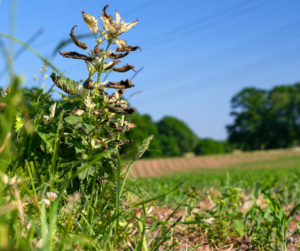
What Foods Are We Talking About?
Genetically modified foods like corn, soybeans, canola, and sugar beets contain the highest concentrations of glyphosate. Their seeds can withstand heavy doses of RoundUp and remain living, whereas the surrounding weeds die. However, there are other crops (non-GMO) where farmers apply RoundUp as a desiccant. This means, they spray it right before harvest to kill the crop and dry it out, making the crop uniformly ready for harvest very quickly – no need to wait for Mother Nature. These non-GMO grains will likely have high levels of glyphosate sprayed on them. Organic grains have also tested positive for glyphosate. WHAT?!?!
“Although most EPA -registered pesticides are prohibited in organic production, there can be inadvertent or indirect contact from neighboring conventional farms or shared handling facilities. As long as the operator hasn’t directly applied prohibited pesticides and has documented efforts to minimize exposure to them, the USDA organic regulations allow for residues of prohibited pesticides at or below 5 percent of the EPA tolerance.” – USDA
Contamination from wind drift is likely a problem for all grains, and pretty much all foods grown outside. Unfortunately – and surprisingly – chickpeas and hummus ranked very poorly for their massive amount of glyphosate contamination. We are so sad about this!!
But if I Don’t Have Cancer, Who Cares?
Aside from cancer, glyphosate causes a host of health issues, like kidney disease, reproductive problems, liver damage, and birth defects. Glyphosate also interferes with the ability of a plant to uptake nutrients from the soil. Therefore, not only are we getting damaged by this chemical, but it’s also damaging the topsoil and living organisms responsible for putting nutrients into our food.
How can one chemical be so harmful in so many ways to the body? Because in reality, glyphosate is killing the bacteria that help us combat toxins, it’s stealing the nutrients we need from our food, and it’s making every other chemical toxin much more harmful. To sum it up, in the words of Dr. Zach Bush:
“The connecting factor is chronic inflammation. And chronic inflammation is the root of all disease.”
Having a diverse microbiome may be the #1 thing we can do to live a long, healthy life. The microbiome doesn’t just consist of what’s living in our gut. It’s also what’s on our skin and in our brain, too. And the communication pathway of the virome is the magic that makes it all work together and makes us resilient against disease.
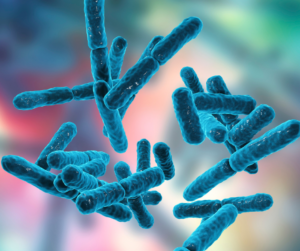
How Can I Tell if I have Glyphosate Toxicity?
Unfortunately, if you eat a Standard American Diet, you can bet you have some level of glyphosate in your system. Yes, especially if you are dealing with any gut issues, fatigue, or chronic disease. This is the main reason we recommend doing a focused liver cleanse (either 10 Day or 21 Day) several times a year. Our stance is that modern life is very toxic. We live in a toxic soup of pollutants in our air, water, food, and homes. Setting aside a few weeks a year for cleansing is a wonderful idea. Chances are, each time you do a cleanse, you’ll feel refreshed, clearer, lighter, and better than you have in years. Cleanses work even if you can’t put your finger exactly on what you’re trying to remove.
That being said, yes, we can run an objective test for you. You can run a hair test (best for kids) or a blood test. The laboratory we run bloodwork through has an Environmental Chemical panel that includes glyphosate, benzene, chloroform, formaldehyde, phthalates, trichloroethylene, and many other harmful chemicals. If you’re curious to know what exposures might be lingering in your system, talk to Claire about setting up an order.

I’m Overwhelmed. Is There Any Good News?!?
Well, yes, of course! We have found some hope for you! It turns out, there is a new food label on the horizon that indicates whether glyphosate has been found within test samples or not. Wouldn’t that be easier, to have safe foods labeled in the grocery store? Yes – and there is a nice long list of foods that have already been tested to be glyphosate-free!
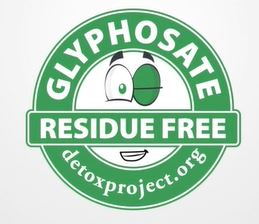
And of course, now that you’re aware of the problem, you can keep a better eye out for good solutions:
- Plan to do a 10-Day or 21-Day Cleanse with us, either in November before the holidays or with our big group in January.
- Take daily liver support supplements to promote detoxification functions on a daily basis. Schedule a nutrition consult and we can help personalize your protocol with targeted support.
- Start being more proactive about choosing organic foods, and rinsing them well with food-grade hydrogen peroxide before consumption.
- Seek out non-dairy “living” probiotic foods to help restore and maintain your gut health. Our favorites include: Kombucha tea, coconut kefir or coconut milk yogurt, Kim Chi, fermented pickles, or raw sauerkraut. Local companies include Ancient Awakenings and Cultured Traditions. Look for them in Whole Foods!
Helpful Supplements
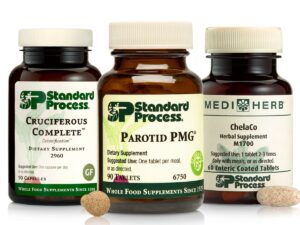
- Parotid PMG – Helps with growth and repair of the parotid gland, involved in saliva production, and removal of toxins from the oral mucosa (especially if you just had your metal fillings removed).
- ChelaCo – Useful for heavy metal detox, acts as a natural chelator. Contains Hawthorn, Garlic and Milk Thistle herbs, all in one. Yes, we can ship to you from our office!
- Cruciferous Complete – Contains kale and Brussels sprouts, provides Indole-3-Carbinol for liver detox, promotes healthy estrogen detoxification. This one is essential if you don’t eat enough of these foods!
Final Words
We hope this information has been enlightening and inspiring to you. Remember these key points – limit your exposures, promote your detoxification, and rebuild your microbiome.
Please send us a message if you’re confused or looking for more info!


